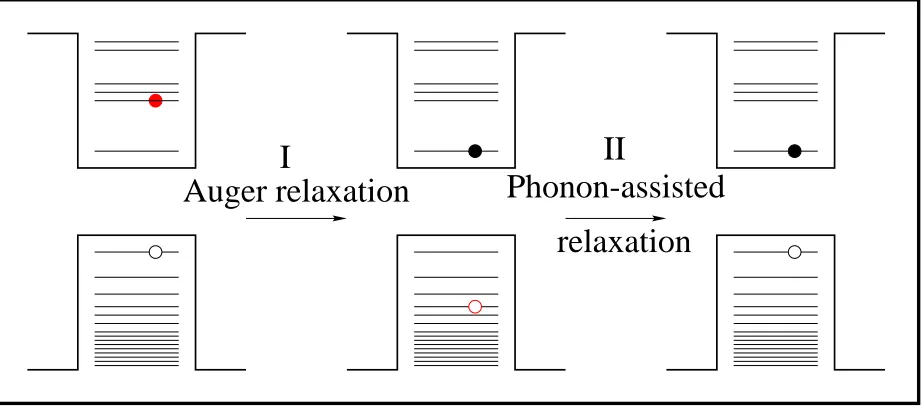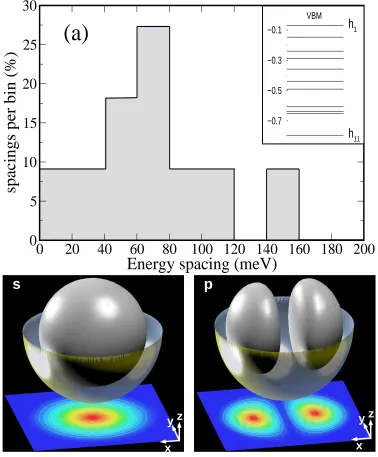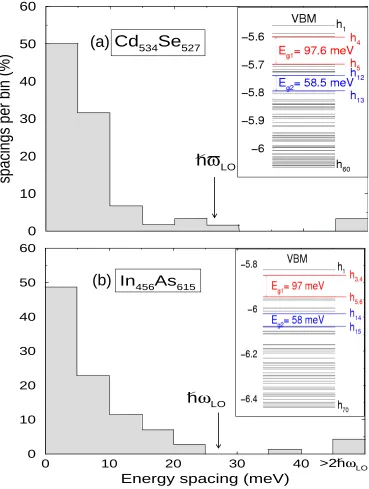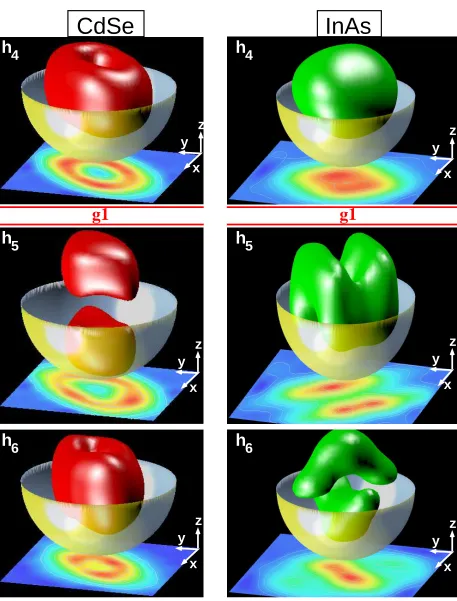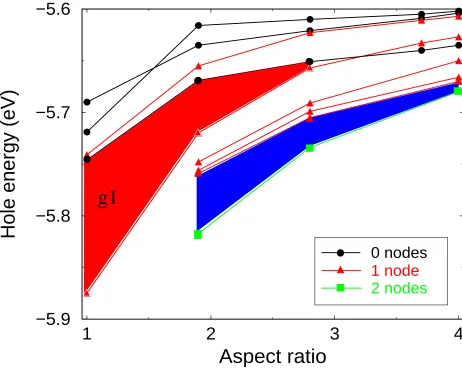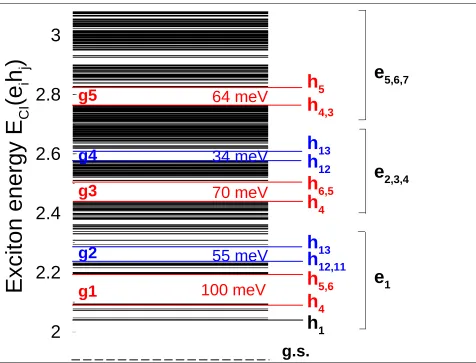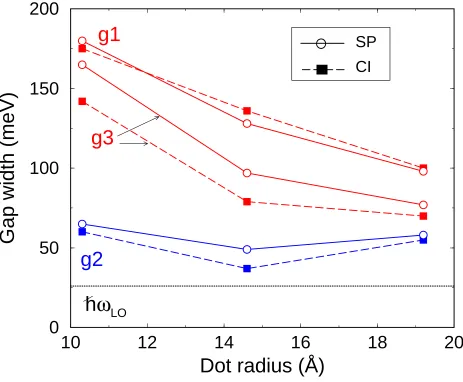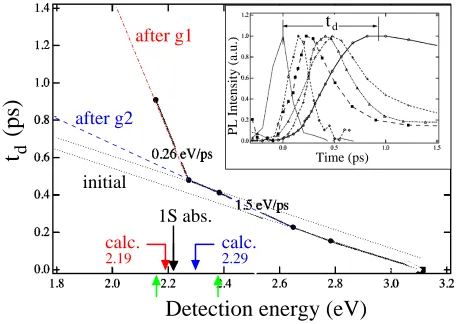promoting access to White Rose research papers
White Rose Research Online
Universities of Leeds, Sheffield and York
http://eprints.whiterose.ac.uk/
This is the author’s version of an article published inNano Letters White Rose Research Online URL for this paper:
http://eprints.whiterose.ac.uk/id/eprint/75644
Published article:
Califano, M, Bester, G and Zunger, A (2003)Prediction of a shape-induced enhancement in the hole relaxation in nanocrystals. Nano Letters, 3 (9). 1197 -1202 . ISSN 1530-6984
Prediction of a shape-induced enhancement in the hole relaxation
in nanocrystals
Marco Califano, Gabriel Bester and Alex Zunger
National Renewable Energy Laboratory, Golden, CO, 80401
Abstract
We present a pseudopotential calculation of the single particle and excitonic spectrum of CdSe
nanocrystals. We find that in the excitonic manifold derived from the ground state electron and
the first 60 hole states there are two energy gaps much larger than the typical LO phonon energy
in bulk CdSe. Such gaps can effectively slow down the hole relaxation process, as recently found
experimentally. We show that they originate from two gaps in the hole spectrum and are therefore a
single-particleeffect, as opposed to anexcitonic effect. The calculated width of the gaps increases with decreasing dot size in agreement with the experimental trend of the energy loss rate that
decreases with dot size. We find that the presence of the gaps is not limited to CdSe nanocrystals
with the wurtzite crystal structure but is also found in spherical InAs zinc-blende dots. Comparison
with our results for quantum rods and cylinders of different aspect ratios, and with a single-band
effective mass model, shows the origin of the gaps to be inter-band coupling in spherical NCs.
The gaps disappear above an aspect ratio of about 3-4, thus predicting a fast hole relaxation for
elongated nanostructures.
The single-particle energy levels in CdSe nanocrystals (NCs) exhibit typical spacings
between electron states of the order of hundreds of meV, and typical energy separations
between hole states of the order of 1-10 meV. This structure, peculiar to 0D systems, was
thought [1, 2] to lead to a “phonon bottleneck” in the electron relaxation from an excited
level to the ground state, since the energy of a LO phonon in bulk CdSe (∼ 26 meV) is much smaller than the inter-electronic level spacing (300 meV for a 1.9 nm CdSe NC).
It was therefore expected that the lifetime of an excited electron would be rather long.
Surprisingly, experiments measure a very fast decay for an excited p electron [3–5], with typical lifetimes that decrease with size from 530 to 120 fs for dots with R = 4.1 to 1.7 nm, i.e. much faster than those relative to phonon assisted relaxation. This fast decay
has been explained [3–5] in terms of an Auger-like relaxation [6] (Fig. 1, step I), whereby
the excited electron can relax to its ground state and the excess energy is transferred via
Coulomb scattering to the hole (which, depending on the experimental setup, might also be
excited in our “initial state”), that is promoted deep into the valence band. Provided that
the spacing between hole levels be of the order of phonon energies, the hole can then relax
very quickly to the top of the valence band by emitting phonons (Fig. 1, step II).
Recently, however, Xu et al. [7] found a dramatic reduction in the hole energy-loss rate
(HELR) in the final stage of the hole relaxation in CdSe NCs: they observed an initial fast
relaxation with a nearly constant rate over a wide energy range, followed by a slow
relax-ation, the spectral onset of which was size dependent. In contrast to electron relaxation that
becomes faster with decreasing dot size (strongly suggesting a non-phonon mechanism, e.g.
Auger-like thermalization), HELRs decrease with decreasing dot size, indicating a different
process from Auger. This was found [7] to be independent on the NC surface passivation
(both TOPO-capped CdSe NCs and TOPO-capped CdSe/ZnS core/shell dots were
con-sidered) and type of solvent used (hexane and toluene), which ruled out the possibility of
invoking a coupling to surface defects to explain slow hole thermalization. Coupling to
phonons was therefore proposed as the underlying mechanism for hole relaxation, also due
to the fact that the observed initial fast relaxation rates were close to those estimated for
hole-LO phonon interactions in bulk CdSe. The reduction of the HELR in the final stage of
the hole relaxation was then attributed by the authors to the opening of a gap in the
exci-tonic manifold between an “absorbing” stateEU
±1 and an “emitting” stateE
L
±1 [8]. Analysis [9] shows that EU
exciton, whereas EL
±1 is a {h1, e1} (i.e. electron and hole ground state) derived exciton. Hence, according to Xu and co-workers [7], the gap is due to many-body (exchange-related)
fine structure associated with (h2, e1) vs (h1, e1).
In this work we will use our semi-empirical pseudopotential method to show that (i) there
are actually two gaps in the excitonic spectrum of CdSe NCs; these gaps are indeed much
larger than the typical LO phonon energy in bulk CdSe and therefore can both effectively
slow down the hole relaxation process; (ii) consequently, the HELR is predicted to change
twice (as opposed to once); this is found to be in agreement with the experimental data;
(iii) the larger gap increases with decreasing NC size in agreement with the experimental
findings of a HELR that decreases with decreasing dot size; (iv)the gaps originate from deep
states (h4, h5, not h1, h2), in the hole spectrum and are a single-particle effect, as opposed to
anexcitonic(i.e. many-body) effect, as proposed by Xu and co-workers; (v) their presence is
not limited to CdSe NCs with the wurtzite crystal structure but is also predicted in spherical
InAs zinc-blende dots; their origin is in the spherical shape of the NC. Elongated rod-like
NCs are predicted to have no such gaps once the axial ratio exceeds 3-4, and therefore are
expected to exhibit fast hole relaxation.
Theoretical methods that were previously applied to nanocrystals [10] provided
informa-tion only on the first few valence eigenvalues and did not detect any gap in them.
Fur-thermore, the k·p approach, when applied to small dots, has been shown [11] to miss many energy eigenvalues near the top of the valence band on account of its overestimate of the
hole confinement. Nor are gaps found in simple models, like the one band effective mass
or particle-in-a-sphere (with infinite barrier potential). Fig. 2a, shows the energies of the
first 10 states below the top of the valence band, corresponding to an energy range of∼0.7 eV, for R = 20 ˚A calculated within the particle-in-a-sphere model. The typical inter-level spacings obtained in this approach for a hole effective mass value of 1.3m0 (CdSe [12]), are of the order of 40-80 meV, for R = 20 ˚A and no proper “gaps” (i.e. spacings much larger than the typical spacing) are found in the valence band. There is therefore a need for a
more accurate theoretical treatment to explain the origins of these gaps.
Here the single-particle energy levelsǫiwere computed with the empirical pseudopotential
method described in Ref. [13], solved within a plane-wave basis, including spin-orbit effects.
The surface of the wurzite dots is saturated by ligand potentials [14]. We use the potential
29.25, and 38.46 ˚A , respectively. We also performed calculations on three rods, with the
same short axis Rs = 29.25 ˚A and aspect ratios Q of long axis over short axis Rl/Rs of
about 2, 3 and 4, and on three CdSe cylinders with the same diameter (d = 29.25 ˚A) and aspect ratios of height over diameter of 2, 3 and 4. The geometry of the rods is ellipsoidal
with the long axis oriented along thez (c) wurtzite axis. With the single-particle orbitals we construct a set of 840 single-substitution Slater determinants. The exciton wavefunctions
are then expanded in this basis set [9] and the many-particle Hamiltonian is solved via CI.
For CdSe spherical dots we computed the first 60 bound hole states below the top of the
valence band, corresponding to an energy range of∼0.5 eV for the largest dot and of∼1 eV for the smallest (see inset in Fig. 3a). We found that the hole spectra of all dot considered
exhibit similar characteristics. As shown in the histogram in Fig. 3a for Cd534Se527, the
typical inter-level spacings are of the order of 1-10 meV, (slightly larger, 1-20 meV, for the
smallest dot, due to increased confinement), with only a few energy levels separated by more
than 25 meV. We label the ground hole state (HOMO) as h1 (Eh1 ≡ Ev) and the excited
states as hn, with n increasing with decreasing hole energy. The LUMO is e1. The hole
single-particle manifolds for all dots present two gaps that are larger than the typical LO
phonon energy in bulk CdSe: the largest gap g1 (of the order of 4~ωLO or more) is always found between the levels h4 and h5 (i.e. at Ev−40 meV for the largest dot and at Ev−95
meV for the smallest dot); the second gap g2 (of about 2~ωLO), is deeper in the valence band and may have different positions in different dots (it is located between levels h12 and
h13, i.e. at Ev −180 meV, in Cd534Se527; between h13 and h14, i.e. at Ev −270 meV, in
Cd232Se235; and between levels h15 and h16, i.e. at Ev−420 meV, in Cd83Se81) [15]. Both gaps can effectively slow down the hole relaxation process. It is important to notice that
the gaps originate from h4 and h5 and deeper states and not from h1 and h2, as implied by Xu and co-workers [7].
Possible explanations of the origin of the gaps within the valence band could be: (i) the
wurtzite structure and the resulting crystal field splitting; (ii) some special features specific
to the CdSe material; (iii) an effect of the dot passivation, or, finally, (iv) the shape of
the NC. To investigate these aspects further, we performed additional calculations for a
spherical InAs zinc-blende, colloidal dot (In456As615), with the same dimensions (R=19 ˚A)
as the Cd534Se527 dot. For this dot the single-particle problem was solved by expanding the
passivated by embedding it in a lattice matched higher band-gap material as it is done in
core/shell structures. As shown in Fig. 3b, the hole manifold for the InAs NC is similar
to that obtained for the CdSe dot (Fig. 3a). The average inter-level spacing is almost the
same as that calculated for the CdSe NC and we find the same two gaps appearing in its
hole spectrum. Both gaps have the same width (to within less than 1%), as the ones we
found in the CdSe NC, with the largest gap again found between the levels h3,4 and h5,6 (in this case doubly degenerate due to the Td symmetry of the system), at Ev −25 meV, and
the second gap found between the levels h14 and h15, at Ev −200 meV. Fig. 4 shows the envelope functions of the states below and above the largest gapg1 for both CdSe (left-hand side) and InAs (right-hand side) NCs withR= 19 ˚A. For InAs we find, on both sides of this gap, states with prevalent pcharacter: on the high energy side, they also have considerable
s (and little d and f) component, whereas on the low energy side they have considerabled
and f (and little s) component. Note that in the single-band approximation (Fig. 2), the levels have pure symmetries (i.e. either s, or p, or d, etc.), and no gaps within the valence band. The existence of the gaps therefore reflects inter-band mixing effects in spherical NCs.
The question now arises as to whether the shape of the NC is relevant for the presence
of the gaps in the hole manifold. We therefore performed calculations on CdSe (Rs = 29.2
˚
A) and InAs (Rs = 38 ˚A) ellipsoidal quantum rods (QRs) with different aspect ratios QQR
ranging from 1 (spherical dot) to 4. Fig. 5, shows the energy of the first 9 hole states at
the top of the valence band (out of the 20 calculated), as a function of the aspect ratio
QQR, for CdSe QRs with Rs = 29.2 ˚A. We find that already for QQR = 2 the gap g1 is
reduced to almost one third (51 meV) of the value it assumes for QQR = 1 (129 meV). On
the other hand, for QQR = 2 another gap (probably derived from g2) opens between the
states h8 and h9 (58 meV). ForQQR∼3 there are three gaps of the order of about 30 meV between the states h3-h4 (29 meV),h5-h6 (34 meV), and h8-h9 (29 meV). Gaps of this size should, however, not compromise the efficiency of the hole relaxation [17, 18]. All these gaps
decrease to a value below the LO phonon energy forQQR= 4, for both CdSe and InAs rods.
A previous pseudopotential calculation [19] of electronic states versus aspect ratio for CdSe
quantum rods of similar sizes as those considered in this work investigated the behaviour as
a function of QQR (starting from QQR = 1) of only the first 4 hole states below the top of
the valence band and therefore did not include the evolution of the gaps we are interested
In order to further investigate the shape dependence of the valence band gaps, we
per-formed calculations on quantum cylinders (QCs) with the same dimensions as the rods (i.e.
h = Rl and d = Rs), and therefore the same aspect ratios QQC = QQR. We found that
already for QQC = 2 there are no gaps larger than ~ωLO in the hole manifold. The gaps
therefore originate from the spherical shape of the dots, and their width decreases with
elongation. Note that the occurrence of the gaps is indeed a shape effect, as opposed to a
volume effect (i.e. the gap decreases with increasing NC elongation, but not because of the
volume increase). In fact, if the important quantity were the volume, the CdSe rod with
Rs = 29.2 ˚A and aspect ratio QQR = 2, having a smaller volume than the CdSe spherical
NC with radiusR = 19.2 ˚A should have a larger gap. As seen in Fig. 5, its gapg1 is instead half as large as that of the spherical dot.
The presence of valence band gaps in spherical NCs is also expected to affect the impact
ionization rates (IIRs) in these systems. In an impact ionization process, a hot electron
in level en decays to the LUMO (e1) and excites a valence electron across the band gap.
For a given electronic excess energy ∆x = Een −Ee1, impact ionization will not occurr if
(Ee1 −Eh4) < ∆x < (Ee1 −Eh5), or, in other words, if the energy made available in the
en →e1 decay process is larger than the energy needed to promote a valence electron from
h4 (above the valence gap) to e1, but smaller than that required to excite an electron from
h5 (below the valence gap) to e1. This energy interval has the width of the valence gap
g1 (∼100−180 meV) and depends on the dot size. When this condition is satisfied there are no valence electrons available to be promoted to the LUMO, while satisfying energy
conservation. Note that since Ee2 −Ee1 >3Eg1, and Eh1 −Eh4 < Eg1/2, ∆x is not enough
to excite an electron fromh1 toe2. The impact ionization efficiency, therefore, drops in that energy interval. This is not the case in the bulk, where the IIR is an increasing function of
∆x.
The presence of valence band gaps might have important consequences on Augerelectron
relaxation processes (Fig. 1, step I) as well. In a typical experimental set-up [20] a visible
pump pulse creates an excited electron-hole pair and a time-delayed infrared pulse is used
to re-excite the electron within the conduction band. If (i) the hole is generated in a state
deeper than h5, and (ii) the electron re-excitation within the conduction band as well as (iii) the Auger electron relaxation are both faster than the phonon-assisted hole relaxation
rather than from h1. In some experimental configurations [5], however, the hole is always allowed to relax to the ground state before the electron is re-excited from e1 to e2 by a IR post-pump.
We next examine whether many-body effects (accounted for through CI), alter the gaps
seen in the single-particle spectrum (Fig. 3). In our CI calculations we include (i)
electron-hole Coulomb attraction, responsible for the creation of bound excitons, (ii) electron-electron-hole
exchange interaction, which splits excitons into spin manifolds. For example [9], the{e1, h1} ground state exciton is four-fold (spin) degenerate in the single-particle approach. The
electron-hole exchange interaction splits it into two doublets: the lowest in energy is spin
forbidden (dark), whereas the highest in energy is spin allowed (bright). We calculated the
excitonic (CI) spectrum for all three CdSe NCs, including 30 hole and 7 electron states. We
find that the same two gaps that were found in the single-particle hole spectrum now appear
in each exciton manifold. The origin of the gaps is therefore a single-particle effect. The
width of the gap decreases with increasing en (the electron level from which the exciton
manifold is derived). Fig. 6 shows the excitonic spectrum for Cd534Se527: we see that the
first two gaps (g1 and g2) are derived from the electron ground state (and from the same hole
states, {h4, h5}, and {h12, h13} as in the single-particle case), whereas progressively higher gaps (g3, g4, etc.), are derived from increasingly higher electron states (and the same hole
states).
In Fig. 7 we present a comparison between the energy gaps calculated in the
single-particle (empty circles and solid lines) and CI (solid squares and dashed lines) approach,
plotted as a function of NC radius. Only the first three gaps (see Fig. 6) are shown. We
find that: (i) Eg1 increases with decreasing dot radius, consistently with the experimental finding [7] that the HELR decreases (i.e. the lifetime increases) with decreasing dot size; (ii)
conversely,Eg2 is rather independent onR; (iii) bothEg1 and Eg2 are almost unaffected by many-body effects (the single-particle results almost coincide with the CI ones, excepted for
the R=14 ˚A dot); (iv) many-body effects reduce higher gaps (the ones derived from excited
electron states) compared to their single-particle values, with larger effects the smaller the
dot (see curve relative tog3 in Fig. 7). Therefore theexistenceof the gaps is a single-particle effect whereas their widthis influenced by many-body effects.
Finally we compare our predictions with experiment. Fig. 8 shows the measured
identified two slopes in that curve, with the change of slope occurring close to the energy
of about 2.22 eV, corresponding to the measured position of the 1S absorption resonance,
indicated by a vertical black arrow. This implies the existence of a single gap within the
valence band, located around∼Ev−70 meV for that specific dot size. Analysis of their data,
however, reveals three different slopes in the energy-loss curve, indicated by the extrapolated
lines in Fig. 8. These slopes correspond to the initial HELR (dotted line), the HELR
after g2 (dashed line), and the HELR after g1 (dash-dotted line). Since the experimental
configuration consists of a hot holehn and a ground state electron e1, no gap other than g1 and g2 is relevant in Fig. 8 (higher gaps involve different electron states). We see that our identification of two gaps (Figs. 3 and 6), is consistent with the appearance of three slopes in
the measured energy-loss curve. Furthermore, the calculated positions of the change in slope
(2.29 eV and 2.19 eV, indicated by blue and red arrows in Fig. 8) are in good agreement
with the experimental curve [21], considering that the calculations were performed for a
slightly larger dot than the experimental one, which yields energy values shifted slightly to
the red, compared to those relative to the experimental dot. The presence of a gap (g2) between two sets of closely-spaced energy levels, could, however, also generate a step-like
jump in the delay time, where the hole relaxation would be fast above the gap, slow across
the gap, and then fast again below the gap, with the slope being approximately the same
above and below the step. The parallel dotted lines in Fig. 8 show that this scenario is
also supported by the experimental data: due to the large energy interval between two
consecutive experimental points, such jump in the delay time could have occurred anywhere
between the two measurements at 2.38 and 2.65 eV and have been therefore undetected.
The (dotted) line through the points at 2.27 and 2.38 eV is consistent with a parallel to
the (dotted) line passing through the experimental points for higher energies. It has to be
mentioned, however, that the first change of slope (the first reduction of the HELR), might
also be within the experimental error, whereas the second is definitely not. In other words
the slopes of the dotted and dashed lines in Fig. 8 might be the same within experimental
error, whereas the dash-dotted line has an indisputably different slope. That is probably
the reason why Xu et al. in their work [7] only referred to the latter change of slope (black
arrow). It has to be pointed out, however, that whereas Xu and co-workers [7] situate the
drop in the HELR at energies just below the first absorption peak 1S (located at 2.2 eV,
at energies above the 1S absorption (which is due to exciton levels originating from h1, h2 and e1). Judging from the experimental curve alone, though, it cannot be excluded that the decrease in the HELR occur just above 2.2 eV, the last experimental point before the
change of slope being at 2.27 eV and the next at 2.16 eV.
Based on the similarities found between the hole manifolds in CdSe and InAs NCs, and the
fact that the LO phonon energies in both bulk materials are also very similar (~ωCdSe LO ∼26
meV, ~ωInAsLO ∼ 27 meV), we predict the same pattern for the hole thermalization in InAs NCs, i.e. an as yet unobserved three-step hole relaxation.
In summary, we have used our pseudopotential calculations to explain the experimental
findings of a reduction in the HELR in the final stages of the hole relaxation in CdSe
quantum dots, in terms of the presence of two gaps in the excitonic spectrum. They have
been shown to derive from two gaps in the hole spectrum which appear unmodified in the
exciton manifold derived from the ground state electron and the first 60 hole states. By
comparison with the results obtained for quantum rods and cylinders with the small axis
equal to the NC diameter and different aspect ratios, the origin of these gaps has been shown
to be the spherical shape of the NCs, as opposed to the crystal wurtzite structure of CdSe.
Furthermore it is shown that the existence of the gaps reflects inter-band mixing effects, as
they are absent in a single-band, particle in a sphere, description. An as yet unobserved
three-steps hole relaxation in InAs NCs is also predicted.
[1] Bockelmann, U.; Bastard, G.Phys. Rev. B1990,42, 8947.
[2] Benisty, H.; Sotomayor-Torres, C. M.; Weisbuch, C. Phys. Rev. B1991,44, 10 945.
[3] Klimov, Victor I.; McBranch, Duncan W.Phys. Rev. Lett.1998,80, 4028.
[4] Klimov, V. I.; Mikhailovsky, A.; McBranch, D. W.; Leatherdale, C. A.; Bawendi, M. G.Phys. Rev. B1999,61, R13349.
[5] Guyot-Sionnest, Philippe; Shim, Moonsub; Matranga, Chris; Hines, Margaret Phys. Rev. B
1999,60, R2181.
[6] Efros, Al. L.; Kharchenko, V. A.; Rosen, M. Solid State Comm.93, 281 (1995).
[7] Xu, S.; Mikhailovsky, A. A.; Hollingsworth, J. A.; Klimov, V. I. Phys. Rev. B 2002, 65,
045319.
[8] Efros, A. L.; Rosen, M. Phys. Rev. B1996,54, 4843.
[9] Franceschetti, A.; Fu, H.; Wang L.-W.; Zunger, A.Phys. Rev. B1999,60, 1819.
[10] Ekimov, A. I.; Hache, F.; Schanne-Klein, M. C.; Richard, D.; Flytzanis, C.; Kudryavtsev, I.
A.; Yazeva, T. V.; Rodina, A. V.; Efros, Al. L.J. Opt. Soc. Am. B 199310, 100.
[11] Fu, H.; Wang, L.-W.; Zunger, A.Phys. Rev. B1998,57, 9971.
[12] Hermann, C.; Yu, P. Y. Phys. Rev. B 21, 3675 (1980).
[13] Wang, L.-W.; Zunger, A. Phys. Rev. B 1995, 51, 17 398; Fu, H.; Zunger, A. Phys. Rev. B 1997,56, 1496.
[14] Wang, L.-W.; Zunger, A.Phys. Rev. B1996,53, 9579.
[15] In addition to these two gaps, that are common to all three dots considered, there are
addi-tional gaps, none of them larger than 2~ωLO, located in different positions for different dots: in Cd83Se81 between h1 and h2 (43 meV) and between h2 and h3 (40 meV); in Cd232Se235 between levels h15 andh16 (40 meV).
[16] Wang, L.-W.; Zunger, A.Phys. Rev. B1999,59, 15806.
[17] Li, X. Q.; Nakayama, H.; Arakawa, Y. Phys. Rev. B1999,59, 5069.
[18] Inoshita, T.; Sakaki, H.Phys. Rev. B1992,46, 7260.
[19] Hu, J.; Wang, L.-W.; Li, L.-S.; Yang, W.; Alivisatos, A. P.J. Phys. Chem. B2002,106, 2447.
[20] Klimov, Victor I. J. Phys. Chem. B2000,104, 6112.
(correspond-ing to the first slow(correspond-ing down of the hole relaxation), around the energy of 2.38 eV (green arrow
in Fig. 8). The change of slope, in fact, is determined by the position of the first experimental
I
relaxation
Phonon-assisted
Auger relaxation
[image:13.595.77.538.74.277.2]II
FIG. 1: Schematics of the electron Auger thermalization (step I) and subsequent hole relaxation
0
20
40
60
80
100 120 140 160 180 200
Energy spacing (meV)
0
5
10
15
20
25
30
spacings per bin (%)
(a)
0.9 1
−0.7 −0.5 −0.3 −0.1
VBM
h
1h
11z y
x
p
z y
x
[image:14.595.116.494.73.530.2]s
FIG. 2: Results for the “particle in a sphere” model, with infinite potential barrier. (a) Main
frame: energy spacing between consecutive hole levels in a spherical CdSe NC withR= 20 ˚A. The sampling bin is 20 meV. Inset: hole spectrum for the same QD. (b) Wave functions squared for the
0 10 20 30 40 0
10 20 30 40 50 60
spacings per bin (%)
>52
h
ϖ
LOCd
534Se
527(a)
0 10 20 30 40
Energy spacing (meV)
0 10 20 30 40 50 60
spacings per bin (%)
In
456As
615h
ω
LO>2hωLO
[image:15.595.123.492.73.562.2](b)
FIG. 3: Pseudopotential calculation: energy spacing between consecutive hole levels in NCs with
g1
g1
InAs
CdSe
h
6
y
z
x
h
6
y
z
x
h
5
y
z
x
h
5
y
z
x
h
4
y
x
z
h
4
y
z
[image:16.595.78.535.63.664.2]x
FIG. 4: Envelope functions squared for hole states above and below the largest gapg1 in NCs with
1
2
3
4
Aspect ratio
−5.9
−5.8
−5.7
−5.6
Hole energy (eV)
CdSe rods: R
s=14.6 Å
0 nodes
1 node
[image:17.595.74.536.95.470.2]2 nodes
g1
FIG. 5: Energy of the first nine hole states below the top of the valence band, as a function of the
NC aspect ratio, for CdSe QRs with Rs = 29.2 ˚A. The different hole states are labeled according
to the number of nodes of the wavefunction along thez direction (long rod axis Rl). The shaded
0.9 1 1.1
2
2.2
2.4
2.6
2.8
3
Exciton energy E
[image:18.595.74.550.87.450.2]CI
(e
i
h
j
)
100 meV
55 meV
70 meV
64 meV
34 meV
g.s.
h
4h
5,6h
12,11h
13h
4h
6,5h
12h
13h
4,3h
5g1
g3
g5
g2
g4
h
1e
1e
2,3,4e
5,6,7FIG. 6: CI excitonic spectrum for Cd534Se527. We denote the single-particle origin of the excitons
10
12
14
16
18
20
Dot radius (Å)
0
50
100
150
200
Gap width (meV)
g1
g2
SP
CI
g3
[image:19.595.74.537.73.455.2]h
ω
LOFIG. 7: CdSe: excitonic energy gaps calculated in the single-particle (SP, empty circles and solid
calc.
2.19
calc.
2.29
initial
after g2
after g1
1S abs.
Detection energy (eV)
d
t (ps)
Time (ps)
PL Intensity (a.u.)
d
[image:20.595.72.528.76.400.2]t
FIG. 8: Changes in slope of the hole energy-loss curve (i.e. the time delay td of the “hot” PL
maximum with respect to a pump pulse [see inset], plotted as a function of the detection energy):
experimental data for a 1.8 nm dot (solid circles, solid line, and HELR values) and theoretical
predictions for a 1.9 nm dot (the red and blue arrows mark the upper energy end of the gaps). The
dotted, dashed and dash-dotted lines emphasize the different slopes in the experimental energy-loss
curve (HELR=dE/dtd). The green arrows indicate the positions of the first experimental points
that determine a new slope in the curve. The black arrow indicates the position of the measured
1S absorption, around which position Xu and co-workers [7] identify the only change in slope in
